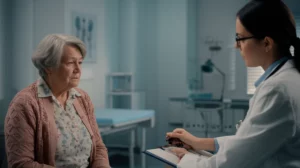Unlocking Hope: Why Early SCID Screening AND Treatment Save Lives
Hey there! Let’s chat about something super important for little ones: Severe Combined Immunodeficiency, or SCID. You might have heard it called “bubble baby disease” back in the day, and while that nickname is a bit outdated, it gives you an idea of how vulnerable these kids are. Basically, their immune system just isn’t working right – their T cells, and often B and NK cells too, are severely impaired. Without a functioning immune system, even a common cold can be life-threatening.
Now, the really tough part is that babies with SCID usually look perfectly healthy when they’re born. But without that immune defense, they start getting really sick, really fast, often within their first few months. Historically, this meant a very high mortality rate in the first year of life. It’s a heartbreaking situation, but thankfully, we have a way to help these kids: Hematopoietic Cell Transplantation (HCT), which is essentially a bone marrow transplant. It’s the only curative treatment available in places like Brazil, where a recent study I read about took place.
The Game Changer: Newborn Screening
So, how do we find these little heroes before the bad guys (infections) show up? That’s where newborn screening comes in! Since around 2010, countries like the USA started implementing universal newborn screening (NBS) for SCID. It’s a simple test, usually done from the same little blood spot collected on filter paper for other newborn tests. They look for something called TRECs (T-cell receptor excision circles). Think of TRECs as tiny little markers left behind when T cells are being made in the body. If a baby has very few or no TRECs, it’s a big red flag that their T-cell production is severely low, which is characteristic of SCID.
Implementing NBS has been a game-changer. In the US, after NBS started, the detected incidence of SCID basically doubled! This doesn’t mean more babies are getting SCID; it means we’re finding them much earlier. We’ve seen pilot programs pop up in other countries too, including Brazil. The city of São Paulo and the state of Minas Gerais in Brazil have started screening, and guess what? They’ve found babies with SCID who otherwise might have been missed until they got terribly sick. This is huge because finding SCID early gives us a fighting chance.

The Brazilian Study: Early Diagnosis vs. Late Diagnosis
The study I was reading looked at 20 SCID patients at a major referral center in Brazil over the last two decades. They wanted to see how the timing of diagnosis affected outcomes. They split the kids into two groups:
- Early Diagnosis: Found through NBS or because there was a family history of SCID (7 patients).
- Late Diagnosis: Found because they were already showing symptoms and getting sick (13 patients).
What they found wasn’t entirely surprising, but it really drives the point home. The kids diagnosed early had a median age at diagnosis of just 41 days. That’s super early! The kids diagnosed late, however, had a median age of 190 days – that’s over six months old! That difference (p elt; 0.001) is statistically significant and shows that NBS is doing its job by catching cases way sooner.
The Survival Numbers: A Stark Contrast
Now, let’s talk survival. This is where it gets serious. The 2-year overall survival rate for the *late diagnosis* group was a grim 29.2%. Think about that – less than a third survived past two years. In stark contrast, the 2-year overall survival rate for the *early diagnosis* group was 71.4%. While the statistical difference wasn’t *quite* at the conventional significance level (p=0.053), it shows a clear and powerful trend: finding SCID early *significantly* improves a child’s chance of survival.
More Than Just Finding It: The Treatment Hurdle
Here’s the twist, though. Even for the kids diagnosed early, getting to the curative treatment – the HCT – wasn’t happening as fast as you’d hope. The median time between diagnosis and transplantation was about 11 months for *both* groups! This is a critical point. Many studies from developed countries show that the best outcomes for HCT happen when it’s done before 3.5 months of age and *before* the child gets serious infections. In this Brazilian study, no one got transplanted that early, and many kids, even in the early diagnosis group, had infections while waiting.
This delay in getting the definitive treatment seems to be a major factor. When they looked *only* at the patients who actually received an HCT, the survival rates between the early and late diagnosis groups were much closer (71.4% vs. 60%). This suggests that while early diagnosis is vital for getting kids into the system and under care, the *real* impact on post-transplant survival comes down to getting that transplant done quickly and ideally before severe infections set in. The study noted that the two patients who didn’t have infections before HCT survived 100%, compared to 60-66% for those who did.

The BCG Vaccine Challenge
Another really important point, especially in countries like Brazil where BCG vaccination (for tuberculosis) is mandatory at birth, is the risk of complications from live vaccines in immune-deficient babies. The study found that 44.4% of the patients had complications from the BCG vaccine. Some had local reactions, but others had disseminated disease (BCGosis), and tragically, some deaths in the late diagnosis group were linked to these complications.
However, among the six patients diagnosed by NBS who started preventive anti-mycobacterial therapy early, only one had a local reaction, and it was successfully treated. This suggests that early diagnosis through NBS allows doctors to start prophylaxis *before* vaccination complications occur, potentially saving lives and preventing severe illness from the vaccine itself. It raises questions about vaccination policies in countries implementing NBS – do you continue mandatory BCG at birth, relying on early prophylaxis via screening, or adjust the schedule? More studies are needed here, for sure.
The Road Ahead: Public Policies Are Key
The researchers are pretty clear: while NBS is making a huge difference in finding these kids, it’s not enough on its own. The biggest hurdle now is the delay in getting them to HCT. This isn’t just a medical problem; it’s a public health and policy issue. Developing countries, like Brazil, need more HCT centers, more trained staff, and better systems to quickly get patients from diagnosis to transplant.
The referral center in the study is trying to tackle this head-on by creating faster pathways for screened babies: dedicated clinics, rapid testing, quicker enrollment in bone marrow banks, and faster referral to transplant teams. But the core problem remains the limited capacity for transplants.

Wrapping It Up
So, what’s the takeaway? SCID is a severe, life-threatening condition, but it’s treatable with HCT. Newborn screening is absolutely essential because it finds babies early, before they get terribly sick, dramatically improving their chances of survival. But just finding them isn’t the whole story. We also need to make sure they can get to that life-saving transplant *quickly*, ideally before infections take hold. This requires investment in healthcare infrastructure and smart public policies, especially in places where resources are stretched thin. It’s about giving these vulnerable babies the best possible start and the chance to live healthy lives.
Source: Springer







